An IoT-Based Solution for Intelligent Farming †
Abstract
1. Introduction and Motivation
- The amount of data exchanged is relatively low and size limited;
- Devices shall have low size and weight;
- To avoid constant battery replacements and/or recharges, a high autonomy is required;
- The geographical area to be covered can be relatively vast;
- The system shall be robust and reliable.
- The presence of irregular slopes with several obstacles;
- Unforeseeable node mobility (sheep);
- Variable node densities due to the flock movement;
- Need for real-time localization, preferably resorting to Received Signal Strength Indicator (RSSI)-based localization;
- Need to ensure the coexistence of an effective control posture mechanism;
- Frequent system reconfigurations by non-technical personnel.
2. Related Work
2.1. IoT/M2M Protocols and Communication Technologies
2.1.1. Physical and Mac Layers
2.1.2. Network Layer
2.1.3. Transport Layer
2.1.4. Application Layer
2.1.5. Low-Power Wide-Area Network Technologies
2.1.6. Non-IP Protocol Stacks for M2M
2.1.7. IoT Gateways
2.2. Animal Monitoring Platforms
3. IoT-Based Stack Architecture for Intelligent Farming Solutions
3.1. WSM and M2M Components
3.2. Gateway
- Alarms: alarms should be raised as quickly as possible in the event of anomalous situations. The gateway collects data from all the animals, so it has a global view that allows it to correlate the received data, thus being a privileged place to detect abnormal situations. For example, if all animals suddenly exhibit a running behavior that may indicate that the flock may be under attack of a predator, and thus an alarm should be raised. A sheep that disappears from all the beacons can have escaped, and so an alarm should also be raised;
- Local management: local web interface, to allow performing on-site administration tasks (e.g., defining the height at which animals are allowed to feed, if the restrictions are active or not, etc.), consult real-time and historical state data, among others. These operations shall be possible through a WiFi or Bluetooth enabled PDA or smartphone, without requiring access to the CP’s web interface;
- Technical management: local web interface, to enable technical interventions, such as tuning the communication parameters to the specific characteristics of the exploration (kind of terrain, dimension of the flock, etc.), as well as to allow system-level debug via the network.
3.3. Computational Platform (CP)
4. Experimental Evaluation
4.1. Evaluation Scenario Conditions
- The µC duration is set to 6 s (due to localization needs) and the MC duration to 60 s (the needed data report periodicity);
- The arrangement of one MC is defined as follows: one µC type 1 (PR), one µC type 2 (C2B) and the remaining ones are reserved for µC type 3 (B2B);
- The area to be covered is set to 10 ha, since, according to the practical experience of our partners, it is the average vineyard size of potential users of the solution;
- The number of beacons needed to cover such area is 20;
- The max number of collars in one property is fixed to 1000;
- The serial port baudrate is set to 115,200;
- The gateway is connected to the Internet through an Ethernet connection.
4.2. Discussion
- The tests performed considered an Ethernet connection between the gateway and the CP. However, most of real scenarios shall be based in cellular connections (2G, 3G, 4G). Since some of these kinds of connections present bandwidth and latency constraints, we are expecting higher values on the time needed to upload the data to the broker. Thus, a deeper study shall be performed in order to assess the minimum bandwidth necessary to avoid congestion on the gateway;
- Receiving data from the serial port is the most predominant delay source, particularly when the number of devices increases. Possible solutions include increasing the baudrate or use other interfaces (e.g., SPI);
- This work did not consider the impact of additional modules that interact with the local database. For instance, the local alarm generator and the local web socket modules may increment the processing overhead. If it turns out to be a problem, it is possible to update the Gateway’s computing microprocessor, without a significant impact in terms of price and energy consumption;
- The fluctuations observed may be a result of other concurrent tasks of the operating system. Consequently, future work shall consider the adoption of the real-time services provided by Linux;
- Evaluating the feasibility of the gateway’s implementation is a step forward in the evaluation of the entire IoT-based stack proposed for intelligent farming solutions. Notwithstanding, there is still work to be done on such stack. Particularly, the network, routing and security modules shall be further developed and evaluated;
- There is also a critical requirement that still needs to be evaluated, particularly the collar’s autonomy. On [22], a theoretical evaluation of such autonomy was presented considering a pre-prototype version of the solution, being expected 3224 h of autonomy with a battery of 2600 mAh. However, we believe that this may decrease under real conditions.
5. Conclusions
Author Contributions
Funding
Acknowledgments
Conflicts of Interest
References
- Tuwanut, P.; Kraijak, S. A survey on IoT architectures, protocols, applications, security, privacy, real-world implementation and future trends. In Proceedings of the 11th International Conference on Wireless Communications, Networking and Mobile Computing, Shanghai, China, 21–23 September 2015. [Google Scholar]
- Ray, P.P. A survey on Internet of Things architectures. J. King Saud Univ. Comput. Inf. Sci. 2018, 30, 291–319. [Google Scholar] [CrossRef]
- Kidd, P.T. The role of the Internet of Things in enabling sustainable agriculture in Europe. Int. J. RF Technol. 2012, 3, 67–83. [Google Scholar]
- Kwong, K.H.; Wu, T.T.; Goh, H.G.; Sasloglou, K.; Stephen, B.; Glover, I.; Shen, C.; Du, W.; Michie, C.; Andonovic, I. Implementation of herd management systems with Wireless Sensor Networks. IET Wirel. Sens. Syst. 2011, 1, 55–65. [Google Scholar] [CrossRef]
- Llaria, A.; Terrasson, G.; Arregui, H.; Hacala, A. Geolocation and monitoring platform for extensive farming in mountain pastures. In Proceedings of the 2015 IEEE International Conference on Industrial Technology, Seville, Spain, 17–19 March 2015. [Google Scholar]
- Rajandekar, A.; Sikdar, B. A survey of MAC layer issues and protocols for Machine-to-Machine communications. IEEE Internet Things J. 2015, 2, 175–186. [Google Scholar] [CrossRef]
- Al-Fuqaha, A.; Guizani, M.; Mohammadi, M.; Aledhari, M.; Ayyash, M. Internet of things: A survey on enabling technologies, protocols, and applications. IEEE Commun. Surv. Tutor. 2015, 17, 2347–2376. [Google Scholar] [CrossRef]
- Sethi, P.; Sarangi, S.R. Internet of Things: Architectures, Protocols, and Applications. J. Electr. Comput. Eng. 2017, 2017, 9324035. [Google Scholar] [CrossRef]
- Naik, N. Choice of effective messaging protocols for IoT systems: MQTT, CoAP, AMQP and HTTP. In Proceedings of the 2017 IEEE International Systems Engineering Symposium, Vienna, Austria, 11–13 October 2017. [Google Scholar]
- IEEE Standard for Low-Rate Wireless Networks. IEEE Std 802.15.4-2015 (Revision of IEEE Std 802.15.4-2011); IEEE: Piscataway, NJ, USA, 2016; pp. 1–709. [Google Scholar]
- Kushalnagar, N.; Montenegro, G.; Schumacher, C. IPv6 over Low-Power Wireless Personal Area Networks (6LoWPANs): Overview, Assumptions, Problem Statement, and Goals; IETF RFC 4919. 2007. Available online: https://tools.ietf.org/html/rfc4919 (accessed on 31 January 2019).
- Shelby, Z.; Hartke, K.; Bormann, C. The Constrained Application Protocol (CoAP)—IETF RFC 7252. 2014. Available online: https://tools.ietf.org/html/rfc7252 (accessed on 31 January 2019).
- Ritchie, M.; Chase, J.; Atwell, M.; Sadjadi, S.; Schloming, R.; Hat, R.; Conway, A.; Shaw, S.; Godfrey, R.; Sustrik, M.; et al. AMQP Advanced Message Queuing Protocol Protocol Specification License. Available online: https://www.rabbitmq.com/resources/specs/amqp0-9-1.pdf (accessed on 26 January 2018).
- OASIS. MQTT Version 3.1.1. Available online: http://docs.oasis-open.org/mqtt/mqtt/v3.1.1/os/mqtt-v3.1.1-os.html (accessed on 25 January 2018).
- Fielding, R.; Gettys, J.; Mogul, J.; Frystyk, H.; Masinter, L.; Leach, P.; Berners-Lee, T. Hypertext Transfer Protocol–HTTP/1.1—IETF RFC 2616. 1999. Available online: https://tools.ietf.org/html/rfc2616 (accessed on 31 January 2019).
- Sigfox. Sigfox Technology Overview | Sigfox. Available online: https://www.sigfox.com/en/sigfox-iot-technology-overview (accessed on 25 January 2018).
- Wang, Y.P.E.; Lin, X.; Adhikary, A.; Grovlen, A.; Sui, Y.; Blankenship, Y.; Bergman, J.; Razaghi, H.S. A Primer on 3GPP Narrowband Internet of Things. IEEE Commun. Mag. 2017, 55, 117–123. [Google Scholar] [CrossRef]
- Ratasuk, R.; Mangalvedhe, N.; Ghosh, A.; Vejlgaard, B. Narrowband LTE-M system for M2M communication. In Proceedings of the IEEE 80th Vehicular Technology Conference, Vancouver, BC, Canada, 14–17 September 2014. [Google Scholar]
- LoRa Alliance. A technical overview of LoRa and LoRaWAN. Available online: https://www.tuv.com/media/corporate/products_1/electronic_components_and_lasers/TUeV_Rheinland_Overview_LoRa_and_LoRaWANtmp.pdf (accessed on 25 January 2018).
- Al-Fuqaha, A.; Khreishah, A.; Guizani, M.; Rayes, A.; Mohammadi, M. Toward better horizontal integration among IoT services. IEEE Commun. Mag. 2015, 53, 72–79. [Google Scholar] [CrossRef]
- SheepIT Project. Available online: http://www.av.it.pt/sheepit (accessed on 15 April 2018).
- Nóbrega, L.; Gonçalves, P.; Pedreiras, P.; Silva, S. Energy efficient design of a pasture sensor network. In Proceedings of the 5th International Conference on Future Internet of Things and Cloud—FiCloud 2017, Prague, Czech Republic, 21–23 August 2017. [Google Scholar]
- Nóbrega, L.; Tavares, A.; Cardoso, A.; Gonçalves, P. Animal monitoring based on IoT technologies. In Proceedings of the IoT Vertical and Topical Summit on Agriculture, Tuscany, Italy, 8–9 May 2018. [Google Scholar]
- Temprilho, A.; Nóbrega, L.; Pedreiras, P.; Gonçalves, P.; Silva, S. M2M Communication Stack for Intelligent Farming. In Proceedings of the 2018 Global Internet of Things Summit (GIoTS), Bilbao, Spain, 4–7 June 2018. [Google Scholar]
- Aijaz, A.; Aghvami, A.H. Cognitive Machine-to-Machine communications for Internet-of-Things: A protocol stack perspective. IEEE Internet Things J. 2015, 2, 103–112. [Google Scholar] [CrossRef]
- Accettura, N.; Palattella, M.R.; Dohler, M.; Grieco, L.A.; Boggia, G. Standardized power-efficient & internet-enabled communication stack for capillary M2M networks. In Proceedings of the Wireless Communications and Networking Conference Workshops, Paris, France, 31 March–3 April 2012. [Google Scholar]
- Vodafone. Narrowband-IoT: Pushing the Boundaries of IoT. Available online: https://www.vodacombusiness.co.za/cs/groups/public/documents/document/vodafone_nb%E2%80%93iot_white_paper_fi.pdf (accessed on 25 January 2018).
- Salman, N.; Rasool, I.; Kemp, A.H. Overview of the IEEE 802.15.4 standards family for low rate Wireless Personal Area Networks. In Proceedings of the 7th International Symposium on Wireless Communication Systems, York, UK, 19–22 September 2010. [Google Scholar]
- Vogli, E.; Ribezzo, G.; Grieco, L.A.; Boggia, G. Fast join and synchronization schema in the IEEE 802.15.4e MAC. In Proceedings of the Wireless Communications and Networking Conference Workshops, New Orleans, LA, USA, 9–12 March 2015. [Google Scholar]
- Al-Nidawi, Y.; Kemp, A.H. Mobility aware framework for timeslotted channel hopping IEEE 802.15.4e sensor networks. IEEE Sens. J. 2015, 15, 7112–7125. [Google Scholar] [CrossRef]
- Specifications | Z-Wave the Public Standard. Available online: http://zwavepublic.com/specifications (accessed on 25 January 2018).
- EPCglobal Inc. Specification for RFID Air Interface EPC™ Radio-Frequency Identity Protocols Class-1 Generation-2 UHF RFID Protocol for Communications at 860 MHz–960 MHz Version 1.2.0; Technical Report; GS1: Brussels, Belgium, 2006. [Google Scholar]
- Farris, I.; Pizzi, S.; Merenda, M.; Molinaro, A.; Carotenuto, R.; Iera, A. 6lo-RFID: A Framework for Full Integration of Smart UHF RFID Tags into the Internet of Things. IEEE Netw. 2017, 31, 66–73. [Google Scholar] [CrossRef]
- Winter, T.; Thubert, P.; Brandt, A.; Hui, J.; Kelsey, R.; Levis, P.; Pister, K.; Struik, R.; Vasseur, J.P.; Alexander, R. RPL: IPv6 Routing Protocol for Low-Power and Lossy Networks; IETF RFC 6550. 2012. Available online: https://tools.ietf.org/html/rfc6550 (accessed on 31 January 2019).
- Sanjay, A.; Arrot, M.; Atwell, M.; Brome, J.; Conway, A.; Godfrey, R.; Greig, R.; Hintjens, P.; O’Hara, J.; Radestrock, M.; et al. AMQP, Advanced Message Queuing Protocol, Protocol Specification. Available online: https://www.rabbitmq.com/resources/specs/amqp0-9-1.pdf (accessed on 5 July 2018).
- Deschambault, O.; Gherbi, A.; Légaré, C. Efficient implementation of the MQTT protocol for embedded systems. J. Inf. Process. Syst. 2017, 13, 26–39. [Google Scholar]
- Grigorik, I. Making the web faster with HTTP 2.0. Queue Dev. 2013, 11, 40. [Google Scholar] [CrossRef]
- Lam, K.H.; Cheung, C.C.; Lee, W.C. LoRa-based localization systems for noisy outdoor environment. In Proceedings of the 2017 IEEE 13th International Conference on Wireless and Mobile Computing, Networking and Communications, Rome, Italy, 9–11 October 2017. [Google Scholar]
- LoRa | Geolocation | Zakelijk KPN Forum. Available online: https://zakelijkforum.kpn.com/lora-forum-16/lora-geolocation-8555 (accessed on 18 January 2019).
- Nair, K.; Kulkarni, J.; Warde, M.; Dave, Z.; Rawalgaonkar, V.; Gore, G.; Joshi, J. Optimizing power consumption in IoT based Wireless Sensor Networks using Bluetooth Low Energy. In Proceedings of the International Conference on Green Computing and Internet of Things, Delhi, India, 8–10 October 2015. [Google Scholar]
- Frank, R.; Bronzi, W.; Castignani, G.; Engel, T. Bluetooth Low Energy: An alternative technology for VANET applications. In Proceedings of the 11th Annual Conference on Wireless On-Demand Network Systems and Services, Obergurgl, Austria, 2–4 April 2014. [Google Scholar]
- Darroudi, S.; Gomez, C.; Darroudi, S.M.; Gomez, C. Bluetooth Low Energy Mesh Networks: A Survey. Sensors 2017, 17, 1467. [Google Scholar] [CrossRef] [PubMed]
- Zhu, Q.; Wang, R.; Chen, Q.; Liu, Y.; Qin, W. IoT gateway: Bridging Wireless Sensor Networks into Internet of Things. In Proceedings of the IEEE/IFIP 8th International Conference onEmbedded and Ubiquitous Computing, Hong Kong, China, 11–13 December 2010. [Google Scholar]
- Guoqiang, S.; Yanming, C.; Chao, Z.; Yanxu, Z. Design and implementation of a smart IoT gateway. In Proceedings of the 2013 IEEE International Conference on Green Computing and Communications and IEEE Internet of Things and IEEE Cyber, Physical and Social Computing, Beijing, China, 20–23 August 2013. [Google Scholar]
- Aloi, G.; Caliciuri, G.; Fortino, G.; Gravina, R.; Pace, P.; Russo, W.; Savaglio, C. A mobile multi-technology gateway to enable IoT interoperability. In Proceedings of the 2016 IEEE First International Conference on Internet-of-Things Design and Implementation, Berlin, Germany, 4–8 April 2016. [Google Scholar]
- Zachariah, T.; Klugman, N.; Campbell, B.; Adkins, J.; Jackson, N.; Dutta, P. The Internet of Things has a gateway problem. In Proceedings of the 16th International Workshop on Mobile Computing Systems and Applications, Santa Fe, NM, USA, 12–13 February 2015. [Google Scholar]
- Datta, S.K.; Bonnet, C.; Nikaein, N. An IoT gateway centric architecture to provide novel M2M services. In Proceedings of the IEEE World Forum on Internet of Things 2014, Seoul, Korea, 6–8 March 2014. [Google Scholar]
- Rodriguez, A. Restful web services: The basics. IBM Developer Works. Available online: http://www.gregbulla.com/TechStuff/Docs/ws-restful-pdf.pdf (accessed on 16 January 2019).
- OneM2M. Available online: http://www.onem2m.org/ (accessed on 16 January 2019).
- The Internet of Things (IoT) Starts with Intel Inside®. Available online: https://www.intel.com/content/www/us/en/internet-of-things/overview.html (accessed on 16 January 2019).
- Smart M2M ToR. Available online: https://portal.etsi.org/TBSiteMap/SmartM2M/SmartM2MToR.aspx (accessed on 16 January 2019).
- Lightweight M2M (LWM2M)—OMA SpecWorks. Available online: https://www.omaspecworks.org/what-is-oma-specworks/iot/lightweight-m2m-lwm2m/ (accessed on 16 January 2019).
- Hunter, J.; Brooking, C.; Brimblecombe, W.; Dwyer, R.G.; Campbell, H.A.; Watts, M.E.; Franklin, C.E. OzTrack—E-Infrastructure to Support the Management, Analysis and Sharing of Animal Tracking Data. In Proceedings of the IEEE 9th International Conference on e-Science, Beijing, China, 22–25 October 2013; pp. 140–147. [Google Scholar]
- E-Pasto—GPS pour Animaux d’Élevage. Available online: https://www.epasto.fr (accessed on 28 November 2018).
- Digitanimal. Available online: https://digitanimal.com/ (accessed on 17 May 2018).
- e-Shepherd—Agersens. Available online: https://www.agersens.com (accessed on 28 November 2018).
- Nofence.no—GPS-Baserte Virtuelle Gjerder for Geiter. Available online: https://nofence.no (accessed on 28 November 2018).
- Brunberg, E.I.; Bøe, K.E.; Sørheim, K.M. Testing a new virtual fencing system on sheep. Acta Agric. Scand. A Anim. Sci. 2015, 65, 168–175. [Google Scholar] [CrossRef]
- Brunberg, E.I.; Bergslid, I.K.; Bøe, K.E.; Sørheim, K.M. The ability of ewes with lambs to learn a virtual fencing system. Animal 2017, 11, 2045–2050. [Google Scholar] [CrossRef] [PubMed]
- ZigBee-based wireless sensor networks for monitoring animal presence and pasture time in a strip of new grass. Comput. Electron. Agric. 2008, 61, 79–87. [CrossRef]
- Huircán, J.I.; Muñoz, C.; Young, H.; Von Dossow, L.; Bustos, J.; Vivallo, G.; Toneatti, M. ZigBee-based Wireless Sensor Network localization for cattle monitoring in grazing fields. Comput. Electron. Agric. 2010, 74, 258–264. [Google Scholar] [CrossRef]
- Nathan, R.; Spiegel, O.; Fortmann-Roe, S.; Harel, R.; Wikelski, M.; Getz, W.M. Using tri-axial acceleration data to identify behavioral modes of free-ranging animals: General concepts and tools illustrated for griffon vultures. J. Exp. Biol. 2012, 215, 986–996. [Google Scholar] [CrossRef]
- Moreau, M.; Siebert, S.; Buerkert, A.; Schlecht, E. Use of a tri-axial accelerometer for automated recording and classification of goats’ grazing behaviour. Appl. Anim. Behav. Sci. 2009, 119, 158–170. [Google Scholar] [CrossRef]
- Schwager, M.; Anderson, D.M.; Butler, Z.; Rus, D. Robust classification of animal tracking data. Comput. Electron. Agric. 2007, 56, 46–59. [Google Scholar] [CrossRef]
- Dutta, R.; Smith, D.; Rawnsley, R.; Bishop-Hurley, G.; Hills, J.; Timms, G.; Henry, D. Dynamic cattle behavioural classification using supervised ensemble classifiers. Comput. Electron. Agric. 2015, 111, 18–28. [Google Scholar] [CrossRef]
- Vázquez Diosdado, J.A.; Barker, Z.E.; Hodges, H.R.; Amory, J.R.; Croft, D.P.; Bell, N.J.; Codling, E.A. Classification of behaviour in housed dairy cows using an accelerometer-based activity monitoring system. Anim. Biotelem. 2015, 3, 3–15. [Google Scholar] [CrossRef]
- Nadimi, E.; Jørgensen, R.; Blanes-Vidal, V.; Christensen, S. Monitoring and classifying animal behavior using ZigBee-based mobile ad hoc Wireless Sensor Networks and Artificial Neural Networks. Comput. Electron. Agric. 2012, 82, 44–54. [Google Scholar] [CrossRef]
- Navon, S.; Mizrach, A.; Hetzroni, A.; Ungar, E.D. Automatic recognition of jaw movements in free-ranging cattle, goats and sheep, using acoustic monitoring. Biosyst. Eng. 2013, 114, 474–483. [Google Scholar] [CrossRef]
- Alvarenga, F.A.; Borges, I.; Palkovič, L.; Rodina, J.; Oddy, V.H.; Dobos, R.C. Using a three-axis accelerometer to identify and classify sheep behaviour at pasture. Appl. Anim. Behav. Sci. 2016, 181, 91–99. [Google Scholar] [CrossRef]
- CowScout. Available online: https://www.gea.com/en/products/activity-detection-cowscout.jsp (accessed on 26 January 2018).
- Cowlar. Available online: https://cowlar.com/ (accessed on 26 January 2018).
- Nóbrega, L.; Pedreiras, P.; Gonçalves, P. SheepIT—An electronic shepherd for the vineyards. In Proceedings of the 8th International Conference on Information and Communication Technologies in Agriculture, Chania, Crete, Greece, 21–24 September 2017. [Google Scholar]
- Agersens. Available online: https://agersens.com/ (accessed on 26 January 2018).
- Cardoso, A.; Pereira, J.; Nóbrega, L.; Gonçalves, P.; Pedreiras, P.; Silva, V. SheepIT: Activity and Location Monitoring. In Proceedings of the INForum 2018—Simpósio de Informática, Coimbra, Portugal, 5–6 September 2018. [Google Scholar]
- Temprilho, A.M. Pastor Virtual. Master’s Dissertaton, University of Aveiro, Aveiro, Portugal, 2017. [Google Scholar]
- Parliament, E. Directive 2010/40/EU of the European Parliament and of the Council of 7 July 2010 on the framework for the deployment of Intelligent Transport Systems in the field of road transport and for interfaces with other modes of transport Text with EEA relevance. Available online: https://eur-lex.europa.eu/legal-content/EN/ALL/?uri=CELEX%3A32010L0040 (accessed on 31 January 2019).
- Zaharia, M.; Xin, R.S.; Wendell, P.; Das, T.; Armbrust, M.; Dave, A.; Meng, X.; Rosen, J.; Venkataraman, S.; Franklin, M.J. Apache spark: A unified engine for big data processing. Commun. ACM 2016, 59, 56–65. [Google Scholar] [CrossRef]
- Proctor, M. Drools: A Rule Engine for Complex Event Processing. In Proceedings of the 4th International Conference on Applications of Graph Transformations with Industrial Relevance, Budapest, Hungary, 4–7 October 2011; p. 2. [Google Scholar]
- Orange Pi Zero. Available online: http://www.orangepi.org/orangepizero/ (accessed on 26 November 2018).
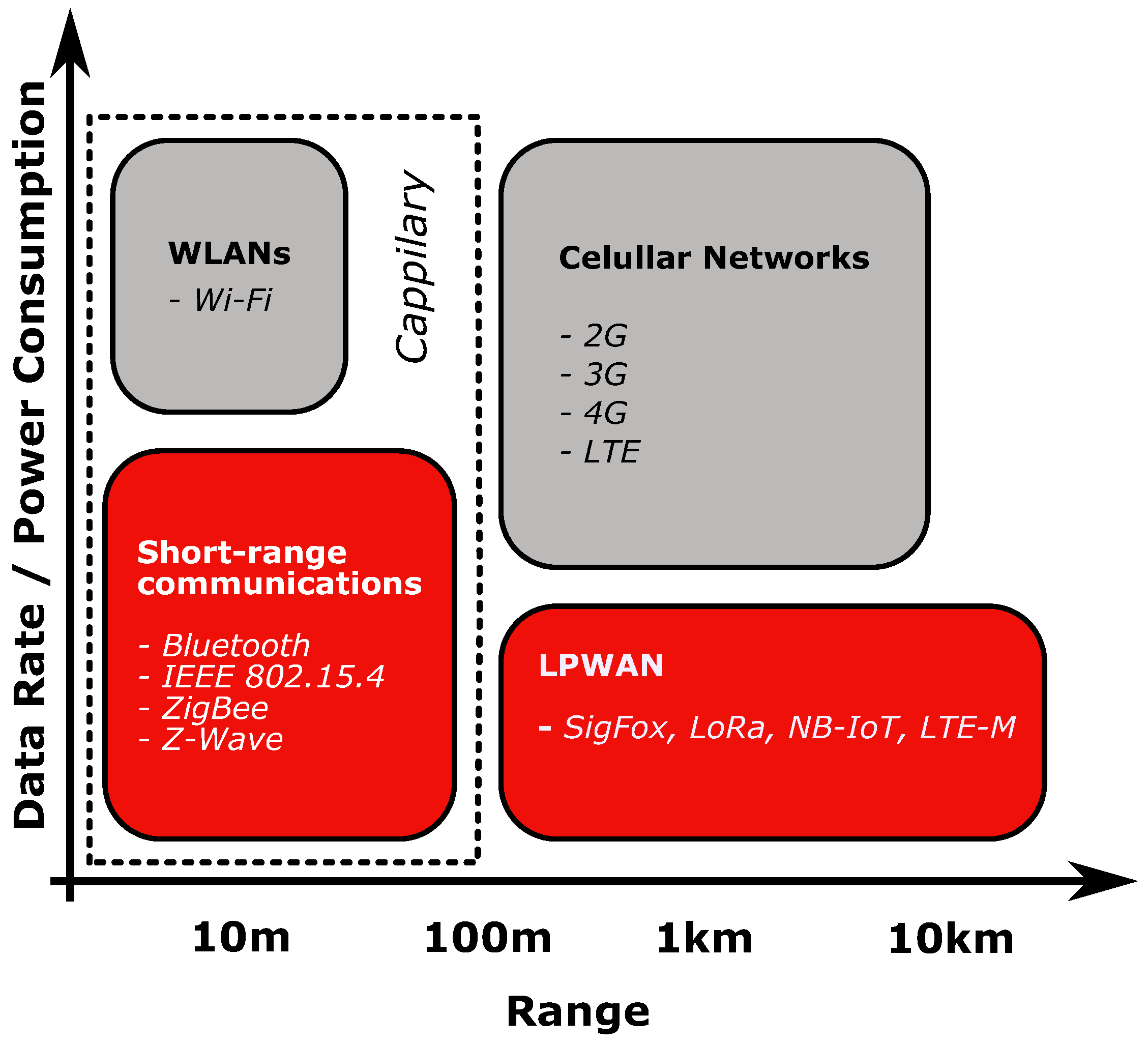
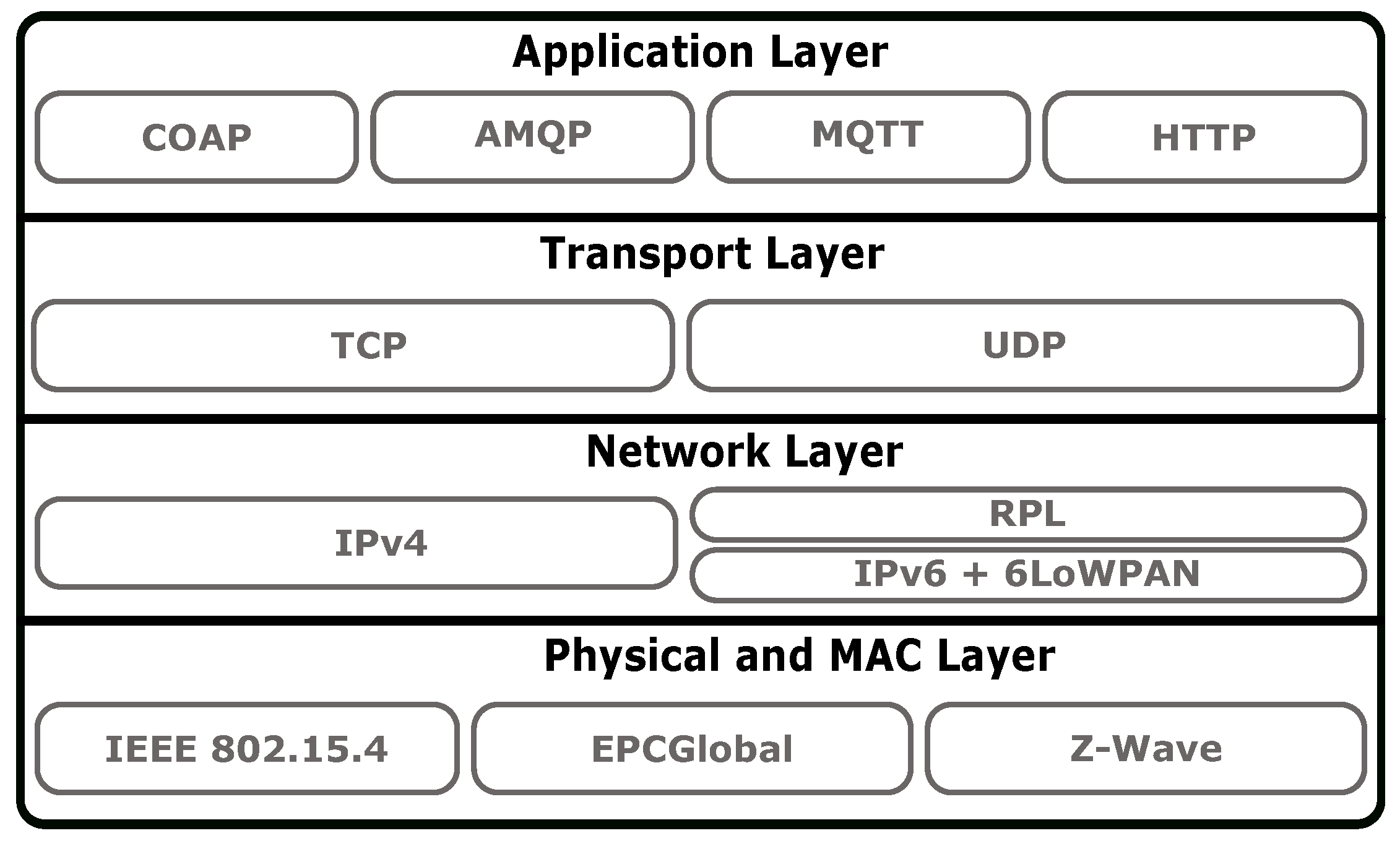
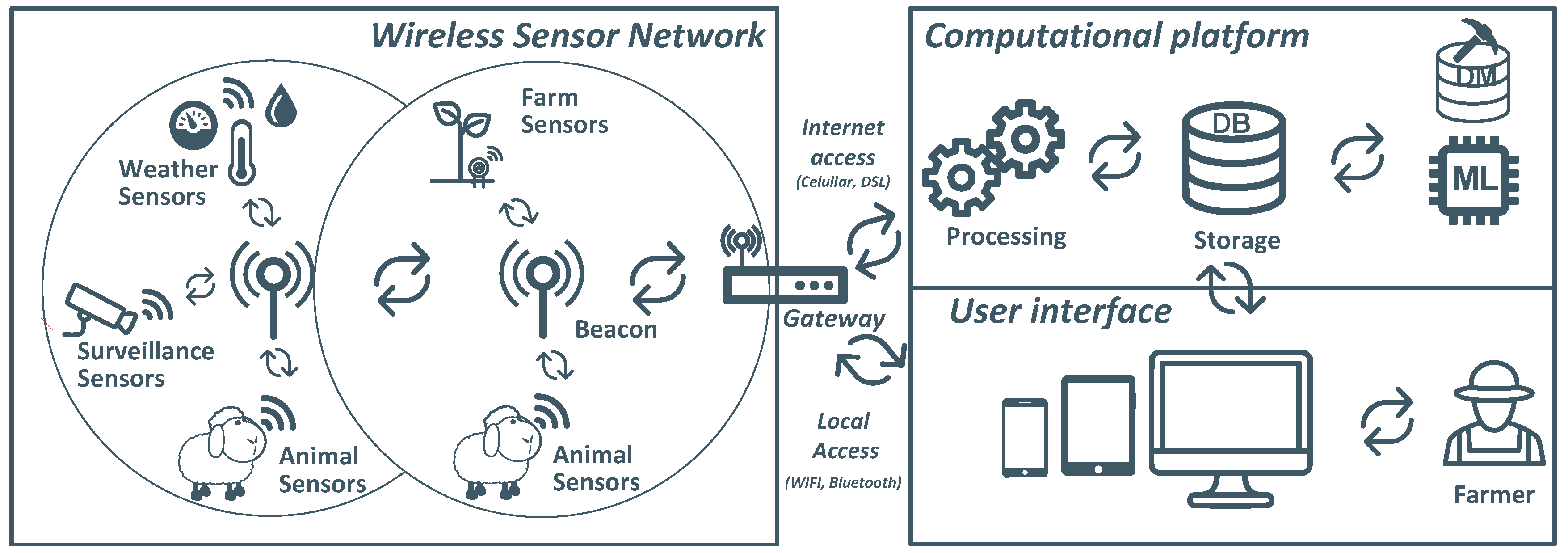
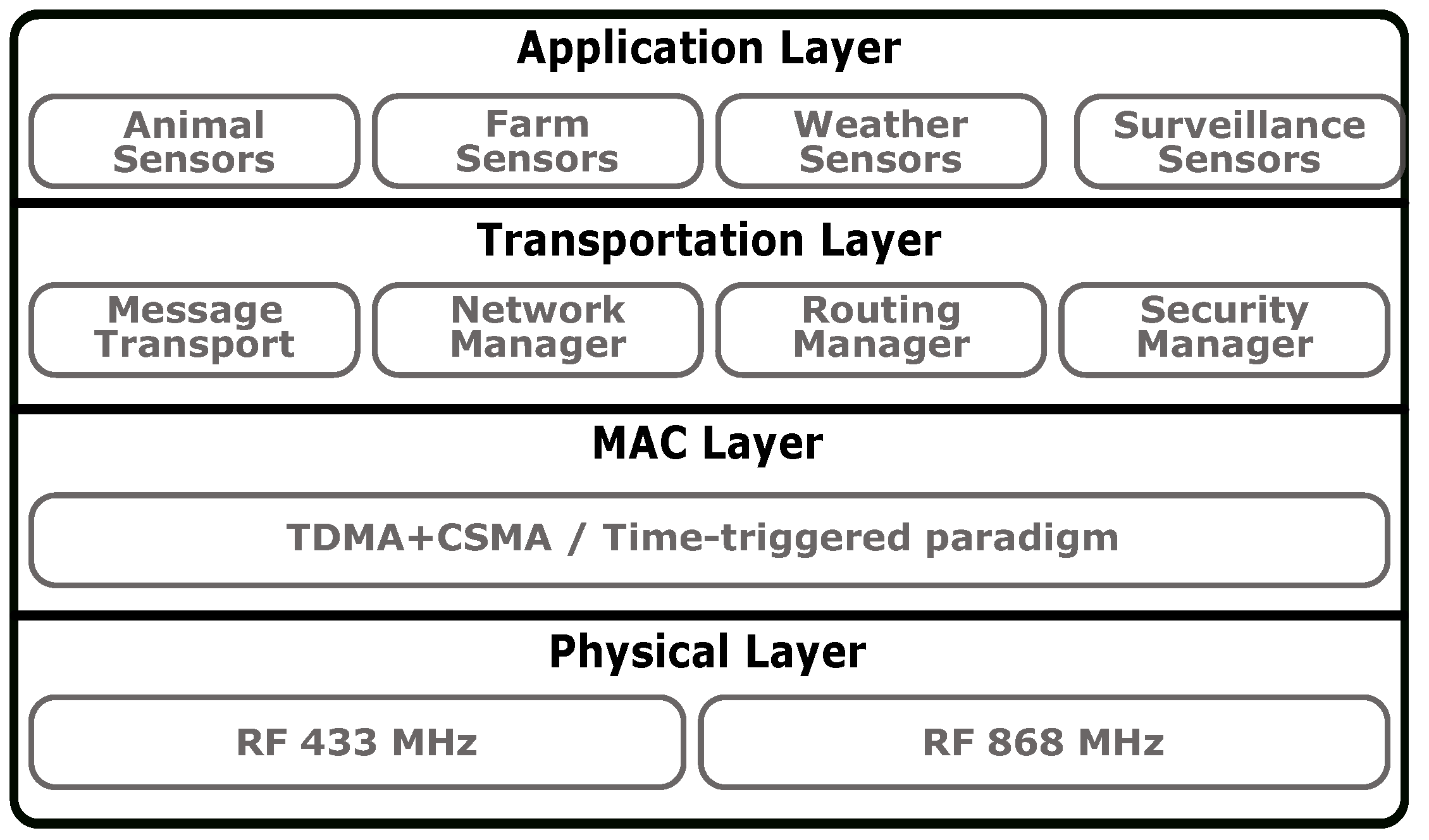
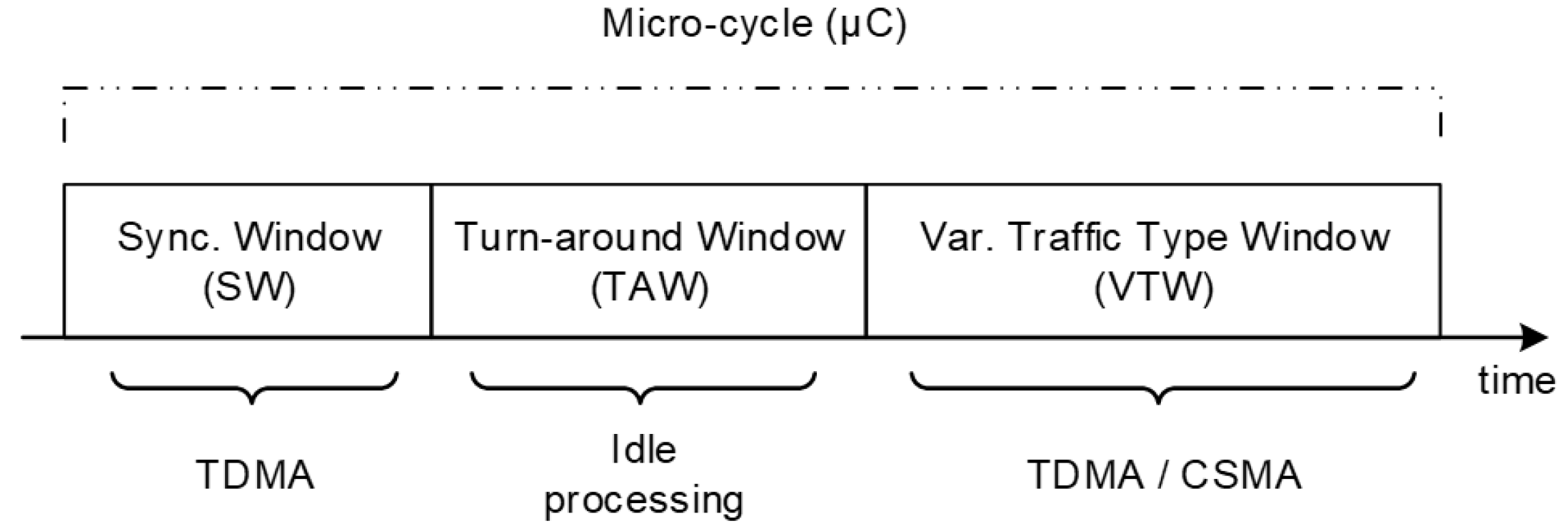
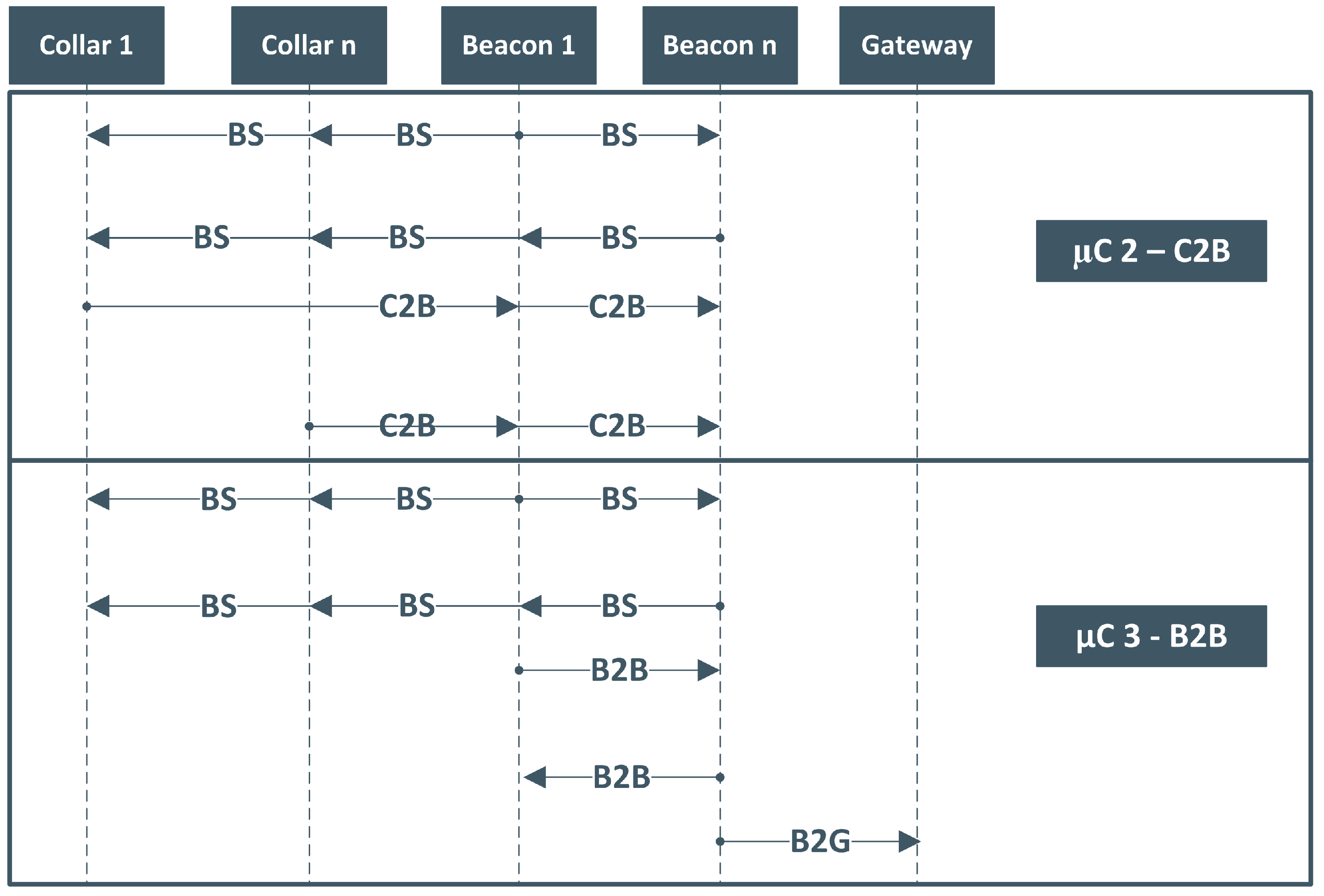

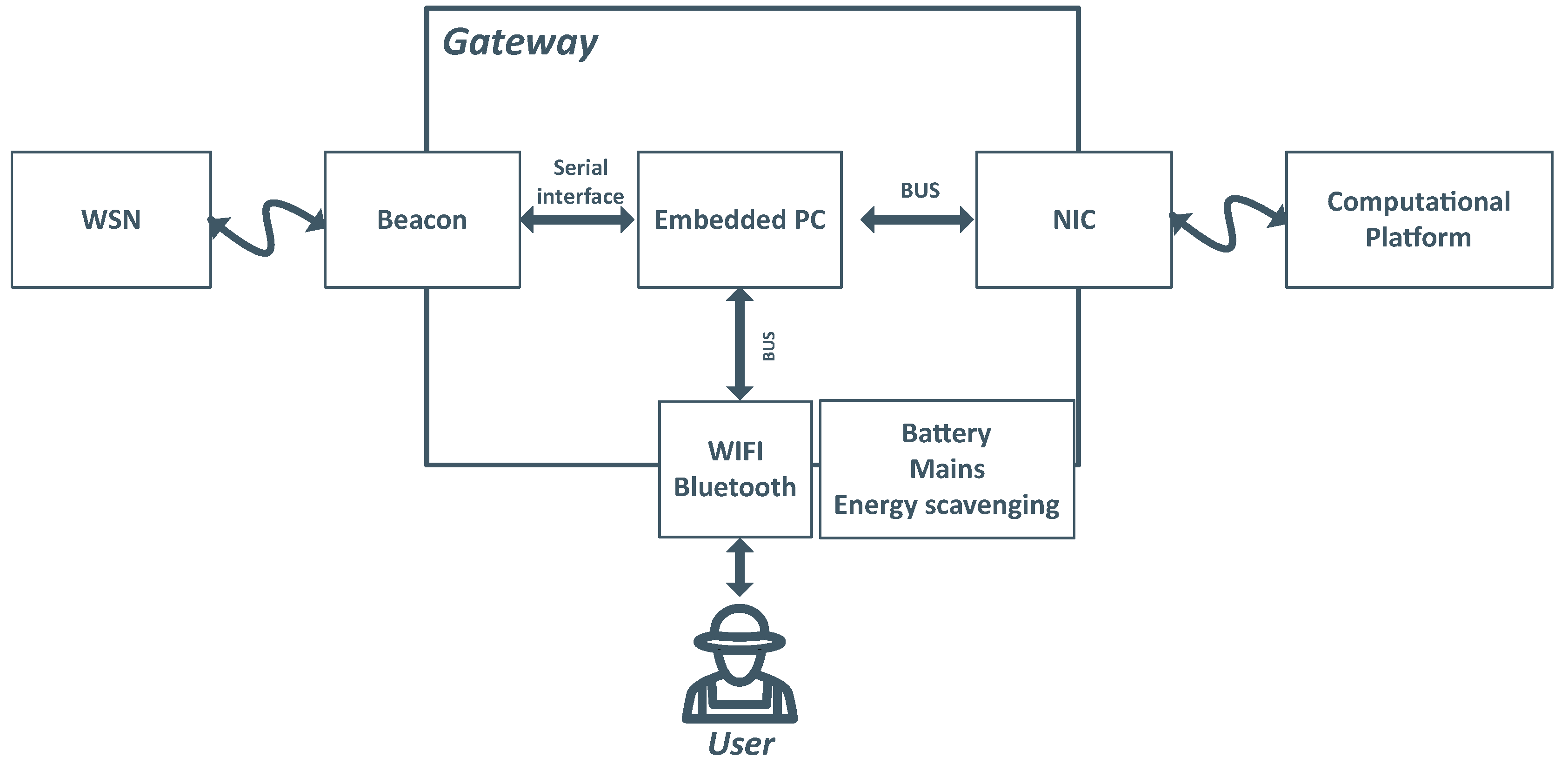

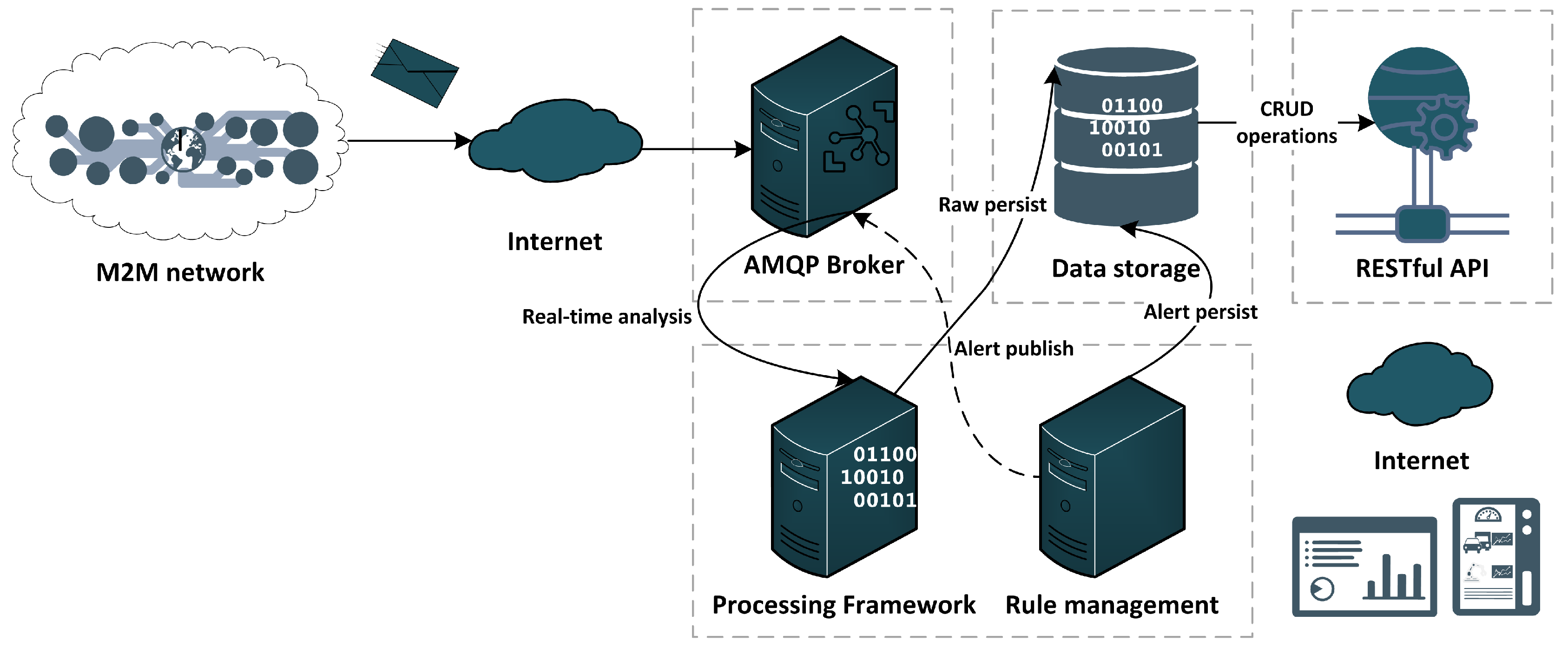
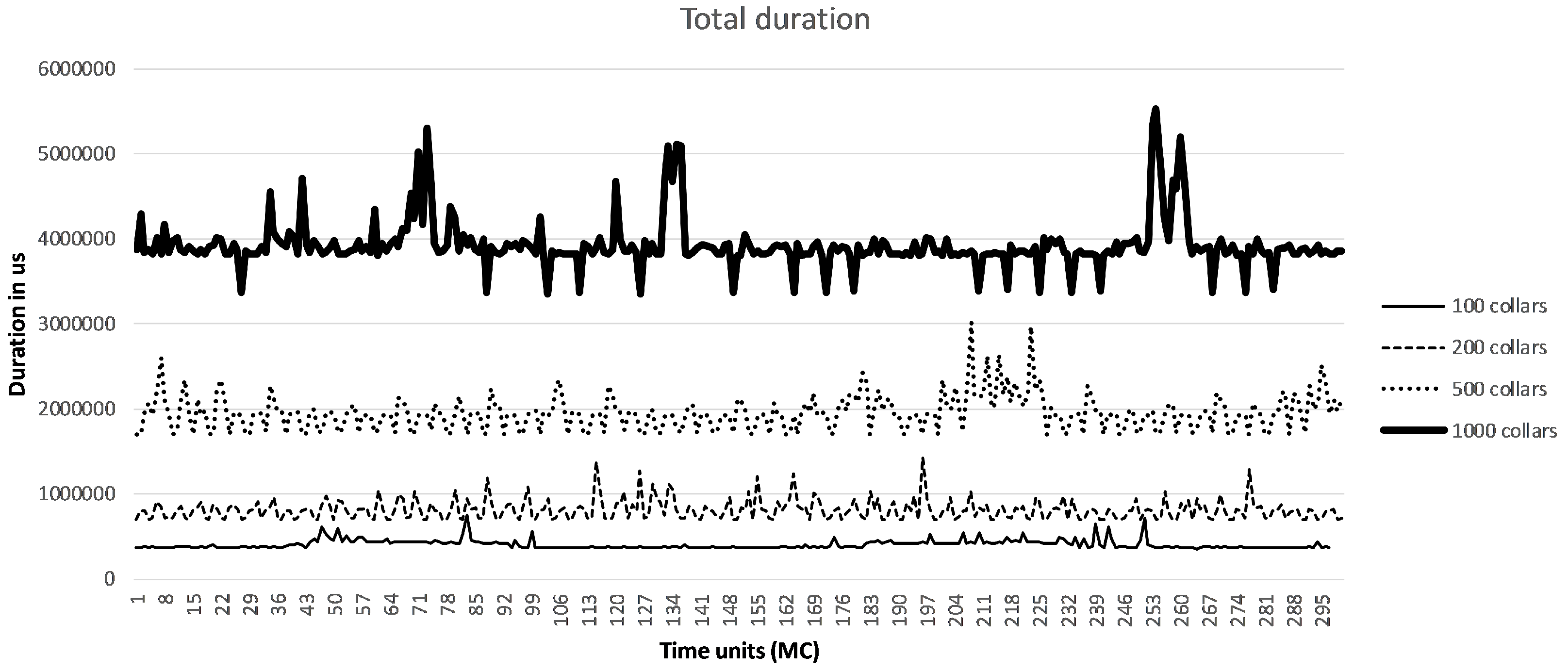
| Feature/Solution | Localization Monitoring | Activiy Monitoring | |||||||
|---|---|---|---|---|---|---|---|---|---|
| Nofence | eShepherd | Digitanimal | Huircan | Nadimi | Cowlar | CowScout | Dutta | Alvarenga | |
| [57] | [73] | [55] | et al. [61] | et al. [67] | [71] | [70] | et al. [65] | et al. [69] | |
| Animals | goats | cattle | several | sheep | sheep | cattle | cattle | cattle | sheep |
| Data gathering | yes | yes | yes | yes | yes | yes | yes | yes | yes |
| Real-Time Data | yes | yes | yes | yes | yes | yes | yes | no | no |
| Localization | GPS | GPS | GPS | RSSI | GPS | no | no | no | no |
| Virtual fence | yes | yes | no | no | no | no | no | no | no |
| Activity Monitoring | no | no | no | no | yes | yes | yes | yes | yes |
| Posture control | no | no | no | no | no | no | no | no | no |
| µC Type—Name | Purpose | MAC Policy |
|---|---|---|
| 1—Pairing Request (PR) | Device’s pairing | CSMA |
| 2—Collar-to-Beacon (C2B) | Collar (mobile nodes) communications | TMDA |
| 3—Beacon-to-Beacon (B2B) | Inter-beacon relay | TMDA |
| Task Duration vs. Number of Collars | 100 | 200 | 500 | 1000 |
|---|---|---|---|---|
| Duration Rx Beacons (ms) | 20.02 | 20.02 | 20.01 | 20.02 |
| Duration Rx Collars (ms) | 331.98 | 661.99 | 1651.97 | 3304.96 |
| Duration Process Beacons (ms) | 0.49 | 0.50 | 0.50 | 0.50 |
| Duration Process Collars (ms) | 2.51 | 4.92 | 12.15 | 24.15 |
| AMQP Library (ms) | 23.19 | 113.15 | 243.63 | 492.60 |
| Cumulative time (ms) | 380.68 | 1483.66 | 1932.25 | 3859.17 |
| Task Duration vs. Number of Collars | 100 | 200 | 500 | 1000 |
|---|---|---|---|---|
| Duration Rx Beacons (ms) | 23.132 | 22.04 | 22.01 | 26.82 |
| Duration Rx Collars (ms) | 333.25 | 668.25 | 1658.69 | 3306.94 |
| Duration Process Beacons (ms) | 2.56 | 2.79 | 2.90 | 3.49 |
| Duration Process Collars (ms) | 15.78 | 26.56 | 66.05 | 130.31 |
| AMQP Library (ms) | 378.80 | 742.18 | 1342.81 | 2082.95 |
| Cumulative time (ms) | 745.84 | 1430.63 | 3028.57 | 5534.48 |
© 2019 by the authors. Licensee MDPI, Basel, Switzerland. This article is an open access article distributed under the terms and conditions of the Creative Commons Attribution (CC BY) license (http://creativecommons.org/licenses/by/4.0/).
Share and Cite
Nóbrega, L.; Gonçalves, P.; Pedreiras, P.; Pereira, J. An IoT-Based Solution for Intelligent Farming. Sensors 2019, 19, 603. https://doi.org/10.3390/s19030603
Nóbrega L, Gonçalves P, Pedreiras P, Pereira J. An IoT-Based Solution for Intelligent Farming. Sensors. 2019; 19(3):603. https://doi.org/10.3390/s19030603
Chicago/Turabian StyleNóbrega, Luís, Pedro Gonçalves, Paulo Pedreiras, and José Pereira. 2019. "An IoT-Based Solution for Intelligent Farming" Sensors 19, no. 3: 603. https://doi.org/10.3390/s19030603
APA StyleNóbrega, L., Gonçalves, P., Pedreiras, P., & Pereira, J. (2019). An IoT-Based Solution for Intelligent Farming. Sensors, 19(3), 603. https://doi.org/10.3390/s19030603





